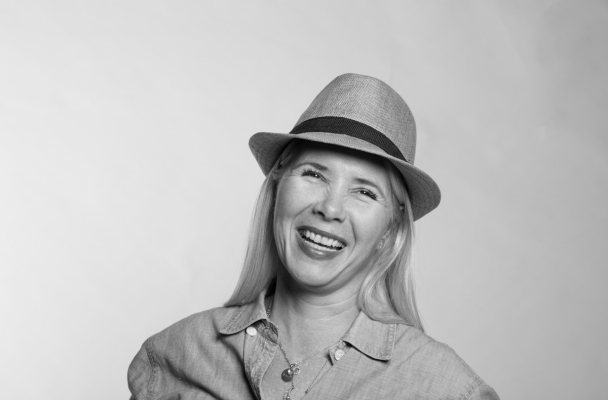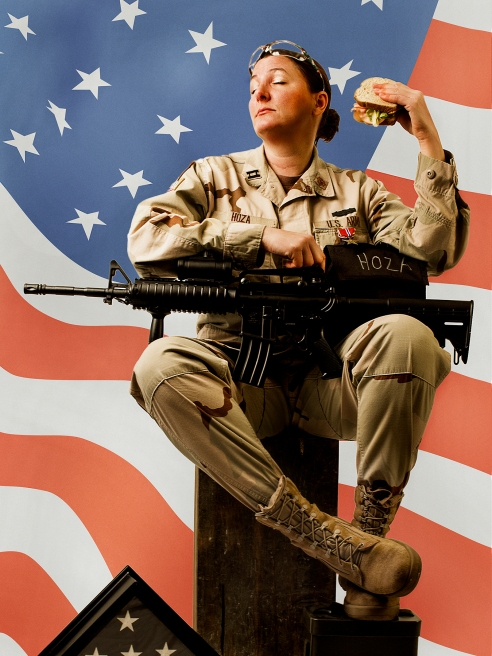Maggie Meiners revisits Rockwell and goes from photographer to artist

Maggie Meiners. Photo by Marcia Mahoney.
When she has something to say, Maggie Meiners has always followed her heart and found a way to say it.
In the early 2000’s, she visited a photography exhibit in London and was so blown away that she decided to leave her teaching career and become a photographer. The fact that she had no formal background or serious previous interest didn’t hold her back. With a supportive husband who understands the creative gene, Meiners would learn as she went, and she continues to make time to do projects that are important to her, even with two young children and challenges of everyday life that demand her time.
Meiners grew up in the Chicago area but attended the Berkshire School in Massachusetts before coming back to DePaul to get her masters in education. Since coming back to Chicago, Meiners has remained in the Chicago area, now in Winnetka where she lives with her husband and children. As she told the Chicago Ambassador, it didn’t take her long to believe in herself as a photographer. However, it wasn’t until her “Revisiting Rockwell” project that she went from considering herself a photographer to considering her an artist. Her project, in which she modernized several famous Rockwell paintings by taking photo reenactments with a contemporary twist came about in much the same way that she decided to first start taking pictures.
About eight years ago Meiners was visiting her prep school alma matter in Massachusetts with her family when she visited the nearby Norman Rockwell Museum. It was during that visit when Meiners had the idea which would transform her from a photographer to an artist.
Rockwell, most famous for his paintings that graced the covers of The Saturday Evening Post magazine, would use photography as part of his process. First, he would draw a rough pencil sketch of the scene he had in mind. Then he would stage his scenes in a series of photographs before making a charcoal sketch and then painting his final color sketch from that. Meiners would stick to photography, staging the scenes as Rockwell did, albeit with an updated message.
One of her most lauded images is also Rockwell’s most famous, commonly known the Thanksgiving painting, or “Freedom from Want.” Rockwell’s 1943 painting featured a traditional family at Thanksgiving Dinner. Meiners does the same, albeit with two men at the head of the table. Another one of Meiners pictures that is getting a lot of attention is “Cock, Bang, Repeat” which is a take on Rockwell’s “Freedom form Fear,” which shows a mother and father putting their sons to bed during World War II. In Meiners update, she shows a single mother putting her sons to bed in the violent city of Chicago.
Meiners’ project, which has now garnered attention throughout the country, was recently displayed at the Vanderpoel Art Association on the South Side. Currently it is on display at Butler Institute of American Art in Youngstown, Ohio. Recently, Bob Chiarito of The Chicago Ambassador met with Meiners at her Evanston studio where she talked about her project and her career and her ideas for her next project.
CA) You were actually a teacher before you were a photographer, correct?
MEINERS) I was. My background is anthropology, that was my undergrad. So you can see that’s it’s infiltrated into my work.
CA) What did you teach?
MEINERS) I taught social studies. Sometimes I taught everything, depending on the school. I taught 5th grade. I taught in Chinatown and up north also.
CA) I read that you never really studied photography?
MEINERS) Not really. I did some workshops but that was about it. I really haven’t had a lot of formal training.
CA) What made you leave teaching and become a full-time photographer?
MEINERS) I went to an photography exhibit in London and had this visceral reaction. I was like, ‘I have to do this.’ It was just one of those things that you have to do. It was just a matter of allowing myself to do it and calling myself an artist and taking myself seriously enough so it didn’t feel like a luxury or some cute little hobby.
CA) Was there a point that you could point to where you bought in and really believed in yourself?
MEINERS) Yes there was actually. I took basically a photo 101 class that taught me darkroom techniques at Northwestern. It was a continuing ed class. Then I took a workshop in Santa Fe and met two other photographers. And we got together and put on a show. They were more seasoned than I was and the fact that my work was up to par with theirs and that they wanted to do a show with me, I was like, ‘Ok.’ They sort of showed me the ropes and I shared a studio with one of them in Wicker Park when I lived there. It sort of snowballed from there.
CA) You’re from Winnetka?
MEINERS) Yes and I spent my high school years in the Berkshire School in Massachusetts and that’s were the Norman Rockwell Museum is. That’s what the impetus was, I was back on campus with my family and went to the museum.
CA) When was that?
MEINERS) That was about 8 years ago. This project has taken me 6 years.
CA) You had never been to the museum when you were in school there?
MEINERS) No. I didn’t have a huge interest in art at the time. I had a little interest but not enough to explore.
CA) Have you heard from anyone at the Rockwell estate about your project?
MEINERS) This was shown at the high school where I went, at the Berkshire School last February. So they saw the show and I’ve met with them. In the ideal world they would buy the 16 prints and use them in their education department. They know about it but it doesn’t seem like they are too interested. I have a feeling that this is a little too familiar with them. Maybe they will circle back to me.
CA) Where were the photos taken?
MEINERS) They were all taken at my old studio in Evanston. I’ve since moved here. They obviously were all taken one at a time.
The first one I conceived of was the Thanksgiving dinner [Freedom from Want] but it was the last one I shot because it took the most people, it was the most complicated one. I started with the ones with featured only one person. I’m also in some of them. I had people help me with the lighting, I don’t really have the background in photography so I lack some of the technical skills. I also had people help me build the sets.
CA) I think it’s even more inspiring because you conceived it and did it, even though perhaps you don’t have the technical skills for every aspect.
MEINERS) Yeah, I basically feel like I did 16 short movies. Every detail was my conception and I directed it and choreographed it. I learned a lot along the way. In some ways it was a little easier than coming up with your own idea because I had this image to work off of, so at times I was like, ‘Put your elbow here.’ The creative process came in the conception rather than the execution if that makes any sense.
CA) Did the ones with more people take a lot longer?
MEINERS) Not really because you’re not looking for a bunch of different poses or different lighting situations. I had a good idea of what I wanted. Where it took time was making sure everyone was according to the picture, and even then they all aren’t identical to the originals.
CA) Rockwell painted hundred of pictures. How did you decide which ones you wanted to revisit?
MEINERS) I think I went with what would be the easiest and also because I didn’t have a huge background with this type of work, but also I picked ones that I could make contemporary. What could I say about different things he did. And there’s more that I’d like to do. I only did three of the four ‘Freedoms,’ which are his most famous works. I still would like to do the ‘Freedom of Speech,’ but it requires a lot of people. It requires a lot of bandwidth, a lot of organization and I’m not sure what my contemporary conception of it is yet. I have an idea but for right now I’m done with the project. I may do one more per year going forward.
CA) How did you get to 16? Did you have them all picked out beforehand?
MEINERS) I didn’t say I was going to do 16. In the beginning I thought I was going to do 50, then it became 25 and I think eventually it got to a point where I felt like it was done. I can come back if I want but it’s one of those things that if I didn’t get it out some of it would have been irrelevant. Well, not really but for instance, the concept for the Thanksgiving one came from Prop 8 in California. I’m at the museum looking at Rockwell’s painting and I thought ‘Who’s to say what defines a family? That’s not fair. To the orphan who has four parents and that’s her family, that’s all she knows, we as a country aren’t going to tell her that she’s wrong. And that picture came out last November so it was a long time since Prop 8. So at some point I had to say ‘I’m done.’ Now that I’m far enough away from it I still revisit this idea of ‘What would this look like’ but I really have to sit down with Rockwell’s work again and see. It’s not something that I can manipulate. It really has to come to me.
CA) Where did you find the people to work with?
MEINERS) I worked similarly to Rockwell, I used all family and friends. Part of that was to imitate his method but it also gave them insight into what I was doing.
Back to your question about what inspires these, it’s a matter of me sitting down and going through his books and looking at the way the world is. I’m sure there’s some political ones that if I didn’t have kids and didn’t have a million things going on that I could have executed before the election, but I don’t work for that. I have to be true to me. Perhaps I’ll do some after the fact.
CA) Some are getting a bulk of the attention, these two especially [updates to “Freedom from Want’ and ‘“Freedom from Fear”Cock]
MEINERS) Some are getting a lot more attention. It’s easier when you see them in person, you can really see the layers and the details and in some cases, the humor. I wouldn’t consider myself a social justice photographer or anything like that, it was just something intellectually that I felt like I had to do. This isn’t how I work.
… I was a little worried about the one with the kids and the gun [Cock, Bang, Repeat’] and I was also a bit worried about commenting on the transgender kid. That doesn’t effect me in terms of anyone in my family but I know a lot of trans people and I’ve learned a lot about it over the years. My point is that neither of these directly effect me but they are happening. So I was concerned about how it was being portrayed, I didn’t want to them to seem like a parody or for people to think they were sarcastic. But what I did was I told myself that I can’t control what people think of it. Many people have really appreciated this and said these are very powerful. I’ve only had one person tell me that she thought I was being coy but I’m sorry, I’m not. This is my art. Like this one [‘Captain Carrie’] — I’m not saying I’m for women in combat, but they are in combat. That’s a new role for them in war compared to Rosie the Riveter. So many of the things I’m trying to say are how it is.
CA) Yeah, your other photos aren’t as much of a social statement, are they?
MEINERS) There’s a little bit of cultural anthropology in there, and then there’s the more formal studies like abstracts and things like that. I sort of have to go with my heart. This project is when I went from calling myself a photographer to an artist because it really isn’t about photography.
CA) I’m no photo expert although to me they look great. To me what really stands out and probably to most people is the statement you are making. Any plans for the exhibit to return to Chicago?
MEINERS) I’m always open to that. For me this work is about creating a dialogue. I think it’s very accessible. There’s a generation who doesn’t know who Norman Rockwell is so this is a great way to reintroduce him. It provokes conversation and nostalgia and I think the more people who can see it, the more it will speak to.
CA) What are your plans for future projects?
MEINERS) I have so many ideas. Right now I have this fascination with the past and I’m looking to find people who have homes in their family that have been there for multiple generations. Whether they bought them from their parents or grandparents or just inherited it. I’d like to examine how our history as individuals can be told through our homes. A lot of it stems from what’s going on in Winnetka. A lot of old homes are being torn down and these new homes are being built. They are beautiful and nice, but a lot of times you don’t get who the people are. You move in and it is filled with all new stuff. I love Ikea and Pottery Barn as much as the next person, but you snap your fingers and you have a new house with all this new furniture but I don’t know who you are. It’s the stories that the things tell us. I hesitate to say heirlooms because that sounds so fancy and it’s not really about objects as much as it’s about the essence of a home. So it’s totally different than what I’ve been doing but it’s also another way to use the past to talk about contemporary things. It’s a very new project and I’m not sure where it’s going to go, but I have this fascination. I feel like we are one of the last generations to appreciate what came before us. And I’m all for change and improvement, but —
CA) It loses character. It’s like if when you go downtown. I don’t want to go to a chain restaurant that I can go to in Phoenix.
MEINERS) Exactly that!
CA) It’s what makes Chicago Chicago or makes whatever other city that city.
MEINERS) I think we’re losing a lot of that.
CA) To get back to the “Revisting Rockwell” project, is there anything that I failed to bring up or ask you about?
MEINERS) I will say one of the things that’s particularly poignant in this that I learned is that despite the changes that have been made in terms of what’s going on today versus back then [in Rockwell’s time], if you notice, there is not a lot of diversity in my models. There’s a little but not a ton and I used all people I knew, right? So there’s a little bit of a testimony there as to how much have things really changed. I didn’t really realize that until I was finished and I was like, ‘Wow.’ In some echelons of society there is really a lack of diversity. It bothers me a little bit and I’m not sure what to do about it but I’m sure at some point something will come out of that observation.
The Revisiting Rockwell exhibit is currently at Butler Institute of American Art in Youngstown, Ohio. To see it online, click here.
Be sure to “Like” us on Facebook!








Leave a comment